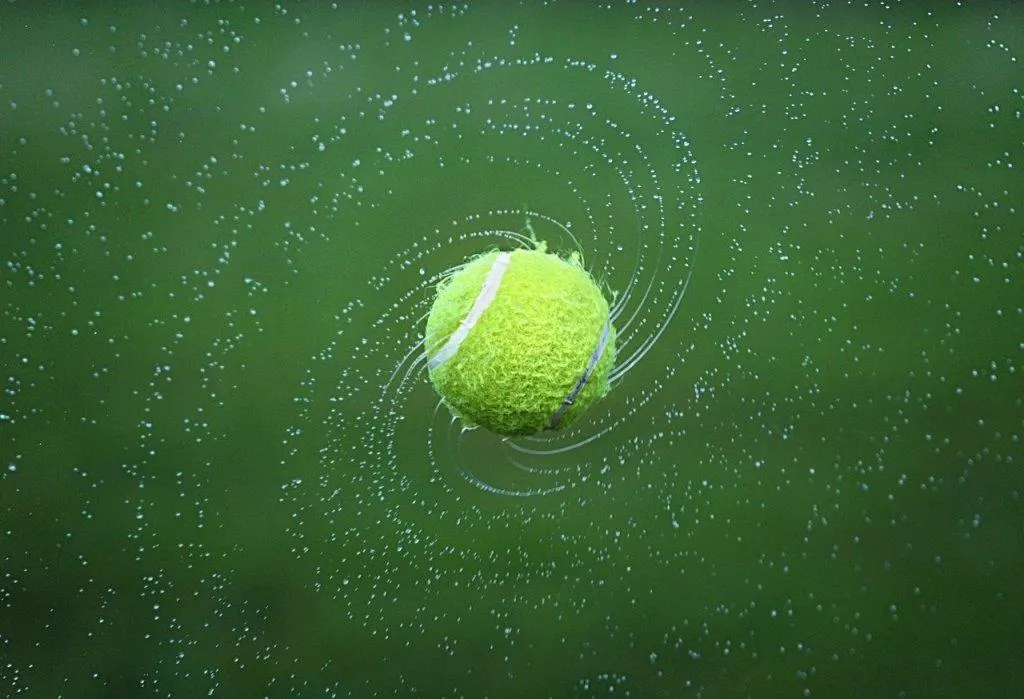
One of the drawbacks of playing tennis outside in the UK is the unpredictable weather. More often than not it’s windy, and rain can spoil some weekends.
As a result, I’m certainly not what you would call a fair weather player. In fact, I’ve learned to adapt to playing tennis with the elements. Otherwise, I’d always be playing tennis inside, which for me isn’t as enjoyable. I enjoy the fresh air as much as playing a regular game of singles or doubles.
In this article, let’s look at how long tennis courts take to dry after a bout of rain, whether you should actually play tennis on a wet court and when it’s really too wet to play a match. Also, read on to discover how you can adapt your game to play tennis in the rain.
As you might expect, tennis courts dry at different rates depending on the temperature, how sunny and windy it is, how good the drainage is underneath and the type of surface you’re playing on.
In short, hard courts usually take about 1-2 hours to dry. For clay courts, they can dry in as little as 30 minutes after some light rain, but over an hour if there’s been a downpour. Grass courts can take a few hours or more to completely dry, depending on how much rain there’s been.
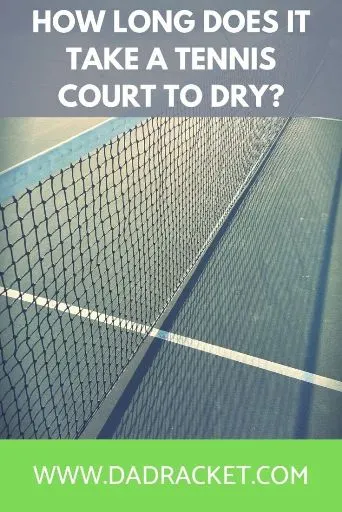
Can you play tennis on a wet court?
Yes, but it depends how wet, what surface you’re playing on, and what sort of tennis game you’re playing. For grass, you should only play if it’s dry. It really is as simple as that. If it’s a friendly doubles match, or just rallying with a training partner, you’ll probably be ok on a hard court if it’s only a little bit wet or damp. However, on a clay court, a bit of rain shouldn’t affect your game too much.
But you should avoid playing a competitive match on a hard court. One quick change of direction, particularly side to side, and you can slip quite easily and injure yourself.
How long does it take a tennis court to dry?
There are many different factors that can affect how quickly a tennis court can dry. Here are a few of them:
- Drainage
- Air temperature
- Wind
- Humidity
The other factor is the type of surface you’re playing on. Here’s a look at clay, hard and grass courts and how long they can take to dry.
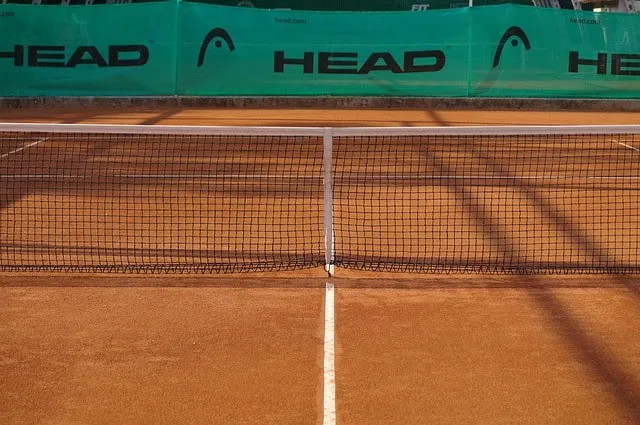
Clay courts
If you were going to pick a surface to play on when it’s a bit wet, it would be clay. This is because you actually need water occasionally to maintain the surface. If it’s left to dry out for too long, the clay can become dusty, hard to play on, resulting in irregular bounces during a match. So if there’s just a bit of light rain in the air, you should be fine playing on clay.
If the rain becomes slightly heavier, you should stop. However, clay courts can dry in as little as 20 minutes so if the weather looks like it will improve, you can start playing again fairly quickly. For heavier downpours, when the clay begins to look a bit muddy, it can take between 1-3 hours to dry.
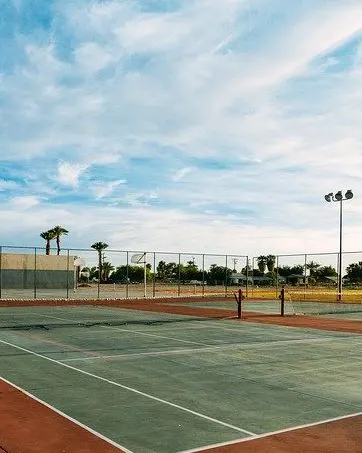
Hard courts
Hard courts usually take longer to dry than clay. Some courts can dry in just 30 minutes, where as others can take over 2 hours. It usually depends on the drainage. There are 8 hard courts near where I live, and after it’s been raining, some dry out faster than others.
Like clay, you can play on hard courts if there’s a tiny bit of rain, but you need to be careful, particularly on the lines as they can become slippery very easily. After a heavy downpour, it can take several hours for hard courts to dry.
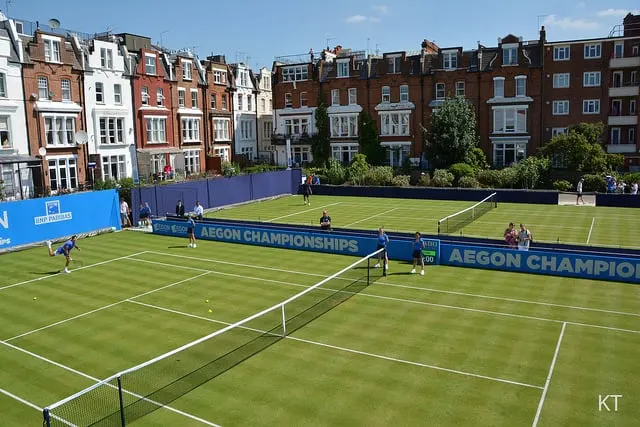
Grass
Unfortunately, grass is the worst surface to play on if it’s been raining. If you watch Wimbledon every year, you see how quickly the staff put the covers on as soon as a bit of drizzle appears. It takes a long time to dry out, even if the surface is only slightly damp.
Under no circumstances should you be playing on a damp or wet grass tennis court. You can easily slip and injure yourself, not to mention the damage you can do to the court.
How to dry a tennis court quickly
At the big tennis tournaments and grand slams, they have a lot of equipment which can help to dry out the court. They can cover the court, which is particularly evident at Wimbledon when the ball boys and ball girls grab the covers as soon as it starts to rain. They seem to get faster at doing this every year! At grand slam events, they can also use large fans to help dry the court faster.
At the recreational level, unfortunately there’s not a lot you can do. For hard courts, you can use a squeegee or a roller to soak up some standing water and spread it around so it dries out quicker.
For small puddles, you can always use a towel. However, the best thing is to let nature take its course. If you’re playing in the summer, once the sun comes out the courts will dry out very quickly.
For clay courts, there isn’t much you can do to dry out the court. You just need to wait until the court is dry enough to play on again.
How can you play tennis in the rain?
If you do decide to play a game of tennis when the court is a bit wet, or it’s just started to lightly rain during a match, you have to adapt your playing style. Here are some tips to come out on top against your opponent:
Avoid using the kick serve
Kick serves are a great weapon to have in your arsenal, as they can ‘kick up’ to an awkward height for the receiver. However on a wet court, the ball will retain more moisture and bounce less, right into the hitting zone of the receiver. Try using flat and slice serves more.
Volley more
During rallies the ball won’t bounce up as high on a wet court, forcing players to hit up on the ball. Therefore a good tactic is to approach the net more and hit more volleys. Points will be quicker and the ball should be in a more comfortable hitting zone. Also, long rallies from the baseline aren’t much fun on a wet court with all the side-to-side running.
Bend your knees
As the ball will be bouncing lower, you should bend your knees more to lower your centre of gravity. This will put you in a better position to hit your shots.
Slice more
Hitting lower bouncing balls is hard enough, so why not make it even harder for your opponent and use the slice. The ball will skid through the court more on the wet surface and keep the ball low.
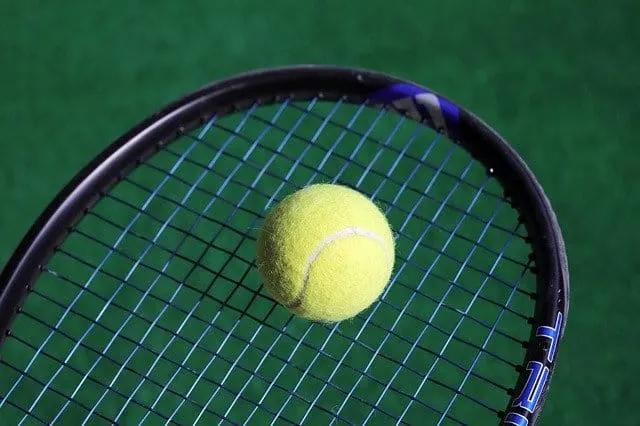
In addition to using these tactics, make sure you are well-equipped for playing in the rain. If you’re wearing some old tennis shoes and it starts raining during a game, you’re going to be in for a torrid time with all the slipping and sliding on the court. Always check the weather forecast before you set off for your game. If there’s any chance of rain, bring tennis shoes with some excellent grip.
Furthermore, bring a towel to wipe down your racket. The handle and grip will get a bit slippery so you need to keep it dry. You’ll probably need a few more tennis balls than usual, as they will collect more moisture from the wet ground and the rain itself.
How wet is too wet too play?
The answer varies from player to player. For some, the slightest drop of rain means they should pack it in and try on another day. I personally think this is a bit extreme. I would only take this approach if I was playing on a grass court. But for hard courts, if the surface is a bit wet, I can usually play ok.
The key for me is to check how slippery the lines are and whether I feel my feet slipping during the warm up. If either of these situations arise, I won’t play a competitive match. I may still do some gentle rallies with an opponent though, without any running or lunging for shots.
For me, if I can see puddles on the court, it means it’s too wet to play!
Conclusion
If you can, try to avoid playing competitive matches in the rain.
You have more chance of slipping over and hurting yourself. Not only that, hitting wetter and heavier tennis balls than usual could result in picking up a nasty arm injury as you will likely swing harder.
However, if you really need your tennis fix, some gentle rallies with a training partner should be ok for a short while on a slightly wet court.
Finally, try to play on clay if you can, as the surface can absorb a fair amount of water before becoming unsafe. Hard courts are ok if they’re only slightly wet, but avoid grass courts at all costs.
FAQs
Does rain ruin tennis balls?
No, although the tennis balls will collect a lot of moisture and water from the court during a match, they will be fine to use again once they’ve dried out. However, you should bring extra tennis balls if you know it’s going to be wet and change them more frequently than normal. Playing with wet tennis balls is not much fun as they don’t bounce as well, and they don’t fly through the air as quickly.
Can tennis rackets get wet?
Yes, if your tennis racket gets wet in a match, it isn’t a big problem. Just make sure you wipe down the handle and grip with a towel or rag every so often. However, you should really use an older racket when you’re playing in the rain. The balls will be heavier due to the moisture they’ve absorbed from the court, which means a heavier contact when they collide with your tennis strings. This can cause your strings to wear out quicker. Furthermore, hitting a heavier ball may result in your picking up a shoulder and arm injury, so be careful.
Also, the grip may wear out quicker if it gets too wet, so bring some extra overgrips when you play in the rain. Save your best tennis racket when the playing conditions are better!
